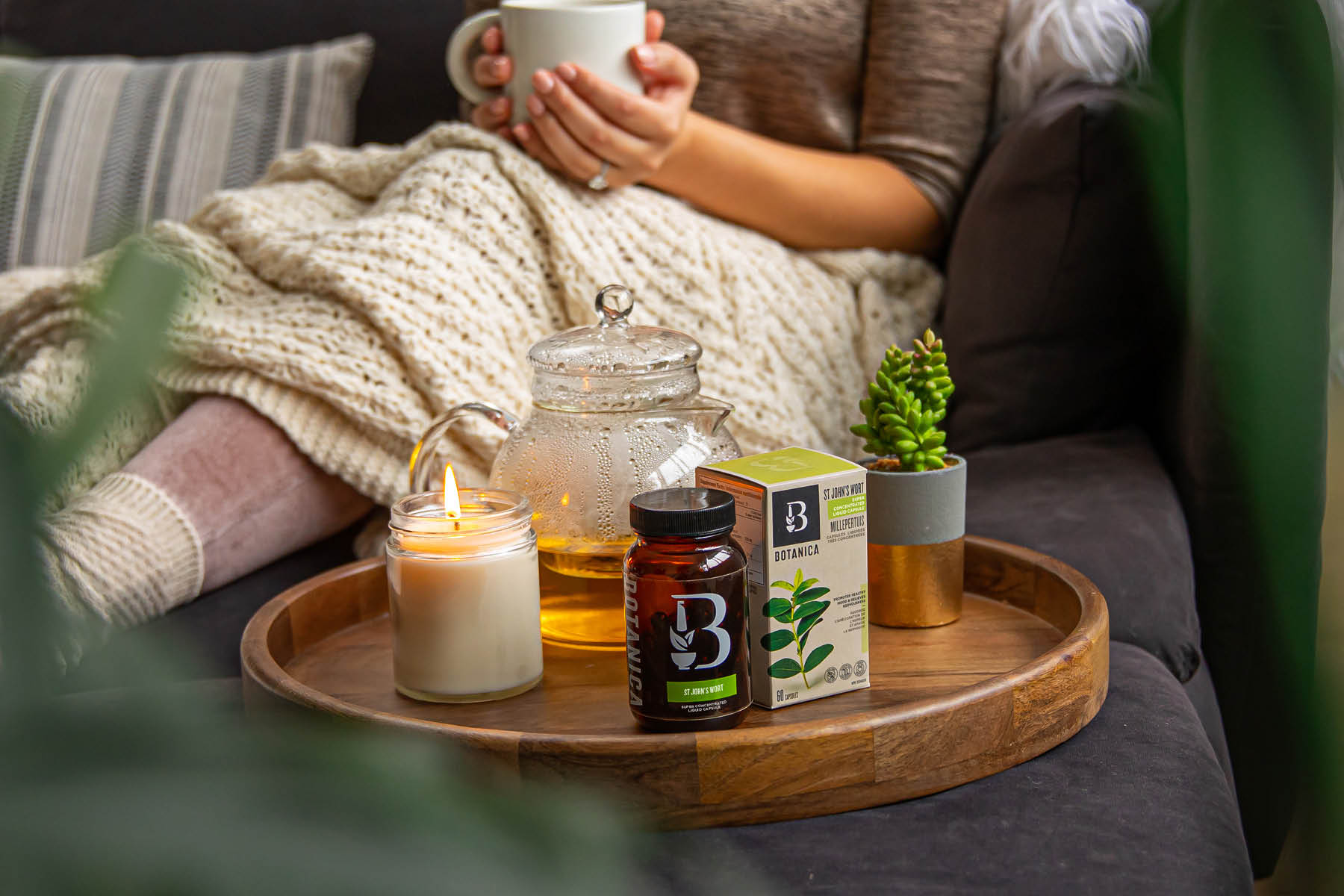Blog
Getting Ahead of Seasonal Affective Disorder
Orsha Magyar, CEO & Founder, NeuroTrition Inc.November 15, 2022

There is a big connection between the weather characteristic of the changing seasons and how we feel. To a certain extent it is perfectly normal to feel a little down during the Fall and Winter months. So you might now be thinking, “Ok, I get the “winter blues – what’s the big deal, doesn’t everybody?” Well, no. You see, about 2- 3% of Canadians suffer from Seasonal Affective Disorder, or seasonal depression as its also called, in its severe form (and another 15% in milder forms).
SAD, as it is very aptly nicknamed, is a big deal because it is a mental illness with very serious signs and symptoms identical to those of major depression. The difference between SAD and depression is that SAD is a specific type of depression that typically starts in Fall, lasts through Winter, and eases up in the Spring and Summer (I say typically because there is a rare type of SAD that starts in Spring and lasts through the Summer).
WHAT DOES Seasonal Affective Disorder LOOK LIKE?
As with depression (and any mental illness, including mood disorders), the symptoms of SAD can vary in severity. For many people, the onset of symptoms, at the start of Fall, is mild but gets progressively more severe throughout Winter before lifting in Spring and over Summer – only to return again during the colder, darker time each year. Here are the most common SAD symptoms:
- Low, depressed mood
- Poor self-esteem and self-worth
- Loss of interest in activities you used to enjoy
- Weight and appetite changes
- Cravings for carb-rich and sweet foods
- Feeling angry, irritable, and stressed
- Anxiety and panic
- Unexplained aches and pains
- Changes in sleeping pattern
- Difficulty concentrating
- Low energy and fatigue
- Reduced sex drive
- Use of drugs or alcohol for comfort
- Feelings of sadness, hopelessness, and despair
- Suicidal thoughts (considered a medical emergency, seek help immediately)
WHAT MAKES US SAD?
Clearly, there is a connection between the shortening of days with a reduction in sunlight and the onset of Seasonal Affective Disorder.
But how are they related? I know you’re wondering.
SAD news (pun intended): Scientists aren’t exactly sure what specifically causes SAD. But they have some ideas – and the HAPPY news is that SAD, like depression, can be treated (more on how, below).
The main hypotheses (aka. smart ideas) about the cause(s) of SAD are:
- Circadian rhythm asynchronicity. This is essentially a disruption in your internal clock, which regulates your mood, sleep and appetite based on changes between light and dark in the environment.
- Serotonin imbalance. This is often referred to as our “happy neurotransmitter” and, while there is no real scientific evidence to support this claim, we do know that antidepressant medications work on this brain chemical, and that serotonin is involved primarily in appetite.
- Melatonin overdrive. Darkness is the spark plug for your pineal gland to produce your “sleep hormone” melatonin. During the ever-shortening days of Fall and Winter our pineal gland may over-produce melatonin, leaving us drowsy, groggy and with low energy.
- Vitamin D deficiency. The science isn’t sure yet whether it is (a) a pre-existing Vitamin D deficiency that is a risk factor for developing SAD or (b) the reduction in sunlight (which helps our bodies make Vitamin D) that causes a Vitamin D deficiency – but we know that a Vitamin D deficiency is part of the SAD story.
Also, it’s important to note that SAD being caused by lack of sunlight does not appear to be the whole story because it may also run in families given that 13 – 17% of people who have SAD have an immediate family member with SAD.
TURNING THAT SAD FACE UPSIDE DOWN
There are a number of natural remedies that you can (and should) try in order to get ahead of Seasonal Affective Disorder but before we get into these more alternative, or holistic, approaches I do feel it is important to tell you about two treatments that are medically approved to treat SAD:
- Medication. One type of antidepressant called an SSRI (Selective Serotonin Re-uptake Inhibitor) works by increasing your brain’s serotonin levels to reduce SAD symptoms. In the U.S. the drug Bupropion (aka. Wellbutrin) is FDA-approved to treat SAD. Talk to your doctor if you are considering this as a part of your treatment plan.
- Therapy. Cognitive Behavioural Therapy (CBT), a type of counselling that helps you change your views about yourself and the world around you, has shown great success in treating SAD. It may even be as effective as antidepressants or light therapy (below) – without the side effects.
If you do choose a conventional treatment plan, I think it is important to combine it with one or more natural approaches to help manage SAD or even possibly help prevent it returning next year.
1. Natural Sunlight
Try your very best to get outside during daylight hours to expose yourself to the sun without sunglasses on (but never look directly at the sun). Try to make a habit of getting outside for a walk on your lunch break or take your coffee break outside if you can stay warm enough.

Now, when it gets too cold to make these suggestions realistic, increase natural light in your home by opening blinds or curtains and moving furniture so you can sit near a window, and trimming hedges or tree branches that might be preventing light from entering your home. You can also trick your brain into thinking there is more light then there really is: Try painting walls in lighter colours and adding lamps, and see the positive impact on your mood.
2. Exercise
I know, you’ve probably heard this one before, but I think it’s important to reiterate nonetheless. Regular exercise, about 30 minutes at least three times a week, is a powerful tool to fight depression, including SAD. Some research suggests that exercise is as effective in treating mild to moderate depression as antidepressants. Powerful, right? It is important to find something that you enjoy, and can make a habit. Continuous, rhythmic exercises where you move your arms and legs may be best, like swimming, weight training or dancing. Even something as simple as going for a walk (if you have a dog, even better!) is a great example.
3. Light Therapy
Also known as phototherapy, light therapy involves sitting in front of a special light box for 15 – 30 minutes every morning and essentially replaces the daylight that is missing in Winter by exposing you to bright light (about 20 times brighter than standard lighting). Light therapy has some solid evidence behind it, with science saying that it can help up to 85% of SAD sufferers [1]. Light therapy should not be started without consulting your doctor, as it can have some side effects. If you are cleared to use it, I recommend doing it daily throughout Fall and Winter months before the typical onset of your symptoms.

4. An Anti-SAD Diet
Diet is gaining respect in the neuroscience world as being an important tool in the fight against mental illness. In general, an optimum diet for brain and mental health is one that is predominantly whole foods and minimal processed, refined ones. Moreover, neurological and psychiatric conditions appear to have some fundamental things in common: 1) Blood sugar imbalance, 2) Inflammation, 3) Oxidative stress (ie. free radical damage) and 4) Gut microbiome disturbance. So I always focus on these four key areas with our clients at NeuroTrition as we approach their brain and mental health conditions. Foods high in omega-3 fatty acids, B vitamins and vitamin D are also a part of the Anti-SAD diet I recommend. Try our brain-healthy version of ramen or neuro-Nicoise salad!
5. Vitamin D
While we know that SAD and a vitamin D deficiency are connected what is less clear, when I look through the research, is whether vitamin D supplements help to treat SAD. My conclusion, at this point based on the science, is that vitamin D on its own may not be able to treat SAD. However, I know the importance of vitamin D well beyond bone health, and work with it for thyroid and brain health (both of which influence the development and severity of depression). Therefore, I do recommend a vitamin D supplement in conjunction with at least one of my other recommendations in the fight against SAD.
6. St. John’s Wort
This plant has been used for centuries to improve mood and mental health, and is available by prescription to treat depression in Europe.
But, how much do we know about the effectiveness of St. John’s Wort for depression?
Well, the results are mixed. For example, one clinical trial showed that neither St. John’s Wort nor Citalopram (an SSRI) was better than placebo [2] whereas another clinical trial showed that St. John’s Wort, Sertraline (another SSRI) and placebo were pretty similar for SAD [3]. One review paper summarizing the results of 35 studies did show that St. John’s wort may be better than placebo and as effective as antidepressants for major depression of mild to moderate severity [4].
We do know that St. John’s wort limits the effectiveness of many prescription medicines, and that taking it with antidepressants can cause a potentially life-threatening elevation of serotonin in your body called Serotonin Syndrome. It is also not recommended if you have bipolar disorder or schizophrenia as it can have dangerous side effects. Bottom line: It is important to talk to your doctor before taking St. John’s Wort.
If it is deemed appropriate for you by your practitioner, I recommend Botanica’s St. John’s Wort Super Concentrated Liquid Capsules for a therapeutic dose of St. John’s Wort in the convenience of a capsule without any aftertaste.
REFERENCES
[1] Pjrek, E., Friedrich, M.E., Cambioli, L., Dold, M., Jäger, F., Komorowski, A., Lanzenberger, A. et al. (2019. The efficacy of light therapy in the treatment of seasonal affective disorder: A meta-analysis of randomized controlled trials. Psychotherapy and Psychosomatics, 89(1), 17-24.
[2] Rapaport, M.H., Nierenberg, A.A., Howland, R., Dording, C.,Schettler, P.J. & Mischoulon, D. (2011). The treatment of minor depression with St. John’s Wort or citalopram: Failure to show benefit over placebo. Journal of Psychiatric Research, 45(7), 931-41.
[3] Sarris, J., Fava, M., Schweitzer, I. & Mischoulon, D. (2012). St. John’s wort (Hypericum perforatum) versus sertraline and placebo in major depressive disorder: Continuation data from a 26-week RCT. Pharmacopsychiatry, 45(7), 275-278.
[4] Apaydin, E.A., Maher, A.R., Shanman, R., Booth, M.S, Miles, J.N.V., Sorbero, M.E., & Hempel, S. (2016). A systematic review of St. John’s wort for major depressive disorder. Systematic Reviews, 5(1),148 – 173.

